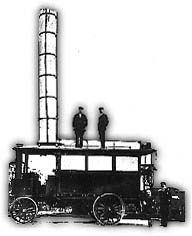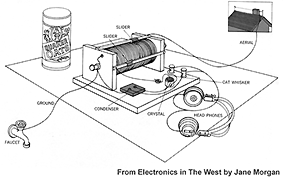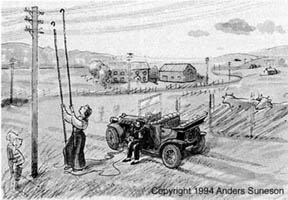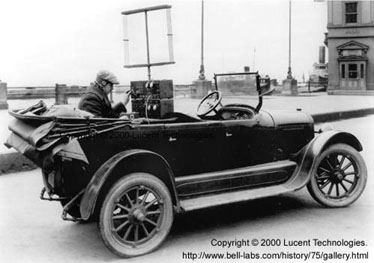
phone
cards
all you need to know about
 |
|
phone | |
all you need to know about | |||
Mobile Telephone History
Page 4 >>
Sunlight was directed onto the mirror, where the vibrations were captured by a parabolic dish. The dish focused the light on a photo-sensitive selenium cell, in circuit with a telephone. The electrical resistance of the selenium changed as the strength of the received light changed, varying the current flowing through the circuit. The telephone's receiver then changed these flucuating currents into speech. Although not related to the mobile telephony of today, Bell's experimenting was a first: radiated electromagnetic waves had carried the human voice. Despite Bell's brilliant achievement, optical transmission had obvious drawbacks, only now being overcome by firms like TeraBeam. Most later inventors concentrated instead on transmitting in the radio bands, with the period from 1880 to 1900 being one of tremendous technological innovation. 1888 on: Radio development begins in earnest In 1888 the German Heinrich Hertz conclusively proved Maxwell's prediction that electricity could travel in waves through the atmosphere. Unlike Hughes, the extensive and systematic experiments into radio waves that Hertz conducted were recognized and validated by inventors around the world. Now, who would take take these findings further and develop a true radio? Dozens and dozens of people began working in the field after Hertz made his findings. It is a miserable job to decide what to report on from this period, with people like Tesla, Branly, and yes, even folks like Nathan B. Stubblefield, claiming to have invented radio. Typical of these events is Jagadis Chandra Bose demonstrating in 1895 electromagnetic waves "by using them to ring a bell remotely and to explode some gunpowder." While not inventing radio, any more than Edison invented the incadesent light bulb, Marconi did indeed establish the first successful and practical radio system. Starting in 1894 with his first electrical experiments, and continuing until 1901 when his radio telegraph system sent signals across the Atlantic ocean, Marconi fought against every kind of discouragement and deserves lionizing for making radio something reliable and useful. Ships were the first wireless mobile platforms. In 1901 Marconi placed a radio aboard a Thornycroft steam powered truck, thus producing the first land based wireless mobile. (Transmitting data, of course, and not voice.) Arthur C. Clarke says the vehicle's cylindrical antenna was lowered to a horizontal position before the the wagon began moving. Marconi never envisioned his system broadcasting voices, he always thought of radio as a wireless telegraph. That would soon change.  On December 24, 1906, the first radio band wave communication of human speech was accomplished by Reginald Fessenden over a distance of 11 miles, from Brant Rock, Massachusetts, to ships in the Atlantic Ocean. Radio was no longer limited to telegraph codes, no longer just a wireless telegraph. This was quite a milestone, and many historians regard the radio era as beginning here, at the start of the voice transmitted age.  Coils of wire, induction at work, changing the frequency of a line, crystal receivers demonstrate many electrical principles. I've built small crystal sets myself and you can find the kits in many places. They are fascinating, operating not off of a battery but only by the energy contained in the captured radio wave. Just the power of a received radio wave, nothing more. As Morgan put it, "Radio receivers with sensitive, inexpensive crystal detectors, such as this double slide tuner crystal set, appeared as early as 1904, and were used by most amateurs until the early Thirties, when vacuum tubes replaced crystals. An oatmeal box was a favorite base upon which to wind the wire coils." The first car-telephone  From 1910 on it appears that Lars Magnus Ericsson and his wife Hilda regularly worked the first car telephone. Yes, this was the man who founded Ericsson in 1876. Although he retired to farming in 1901, and seemed set in his ways, his wife Hilda wanted to tour the countryside in that fairly new contraption, the horseless carriage. Lars was reluctant to go but soon realized he could take a telephone along. As Meurling and Jeans relate, "In today's terminology, the system was an early 'telepoint' application: you could make telephone calls from the car. Access was not by radio, of course -- instead there were two long sticks, like fishing rods, handled by Hilda. She would hook them over a pair of telephone wires, seeking a pair that were free... When they were found, Lars Magnus would crank the dynamo handle of the telephone, which produced a signal to an operator in the nearest exchange." [Meurling and Jeans] Thus we have the founder of Ericsson, that Power of The Permafrost, bouncing along the back roads of Sweden, making calls along the way. Now, telephone companies themselves had portable telephones before this, especially to test their lines, and armed forces would often tap into existing lines while their divisions were on the move, but I still think this is the first regularly occurring, authorized, civilian use of a mobile telephone. More on mobile working below. Around the middle teens the triode tube was developed, allowing far greater signal strength to be developed both for wireline and wireless telephony. No longer passive like a crystal set, a triode was powered by an external source, which provided much better reception and volume. Later, with Armstrong's regenerative circuit, tubes were developed that could either transmit or receive signals. They were the answer to developing high frequency oscillating waves; tubes were stable and powerful enough to carry the human voice and sensitive enough to detect those signals in the radio spectrum.  In 1919 three firms came together to develop a wireless company that one day would reach around the world. Heavy equipment maker ASEA, boiler and gas equipment maker AGA, and telephone manufacturer LM Ericsson, formed SRA Radio, the forerunner of Ericsson's radio division. Svenska Radio Aktiebolaget, known simply as SRA, was formed to build radio receivers, broadcasting having just started in Scandinavia. (Aktiebolaget, by the way, is Swedish for a joint stock company or corporation.) Much unregulated radio experimenting was happening world wide at this time with different services causing confusion and interference with each other. In many countries government regulation stepped in to develop order. In the United States the Radio Act of 1912 brought some order to the radio bands, requiring station and operator licenses and assigning some spectrum blocks to existing users. But since anyone who filed for an operating license got a permit many problems remained and others got worse. In 1921 United States mobile radios began operating at 2 MHz, just above the present A.M. radio broadcast band. For the most part law enforcement used these frequencies. [Young] The first radio systems were one way, sometimes using Morse Code, with police getting out of their cars and then calling their station house on a wired telephone after being paged. As if to confirm this, a reader recently e-mailed me this paragraph. The reader did not include the author's name or any references, however, the content is quite similiar to Bowers in Communications for a Mobile Society, Sage Publications, Cornell University, Beverley Hills (1978): "Until the 1920s, mobile radio communications mainly made use of Morse Code. In the early 1920s, under the leadership of William P. Rutledge, the Commissioner of Detroit Police Department, Detroit, Michigan police carried out pioneering experiments to broadcast radio messages to receivers in police cars. The Detroit police department installed the first land mobile radio telephone systems for police car dispatch in the year 1921. [With the call sign KOP!, ed.] This system was similar to the present day paging systems. It was one-way transmission only and the patrolmen had to stop at a wire-line telephone station to call back in. On April 7, 1928, the first voice based radio mobile system went operational. Although the system was still one-way, its effectiveness was immediate and dramatic." The first car mounted radio-telephone Police and emergency services drove mobile radio pioneering, therefore, with little thought given to private, individual telephone use. Equipment in all cases was chiefly experimental, with practical systems not implemented until the 1940s, and no interconnection with the the land based telephone system. Having said this, Bell Laboratories does claim inventing the first version of a mobile, two way, voice based radio telephone in 1924 and I see nothing that contradicts this, indeed, the photo below from their site certainly seems to confirm it! 
|